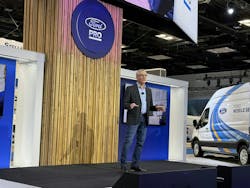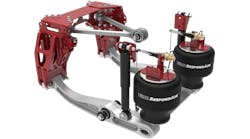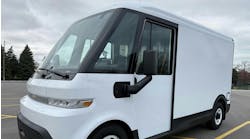GM Envolve
General Motors was the No. 1-selling OEM for fleets in 2024 and has already seen a 17% year-over-year increase in sales for 2025, according to Jennifer Costabile, GM Envolve’s general director of marketing and sales. Costabile attributes that success to GM’s wide range of products, which offer “a vehicle for every industry in every location,” including EVs.
The Chevrolet Silverado EV is one of those that has demonstarted it can fit into certain fleet applications.
Watch: Fleet Maintenance Chevy Silverado EV walkthrough
While at the show, one dealer told her that an Albany, New York-based GM customer that previously delivered parts across town using a Silverado 2500 now does do with the electric version.
“They take a lot of gas,” Costabile pointed out of the 2500. “The Silverado EV did the same thing for significantly less. There's no idling, there's no gas to fill up, and the small routes they did—even in cold weather—was not an issue.”
As Tesla's EV market dominance recedes, companies like General Motors have chipped away at the EV market share of the technology company cloaked as an auto manufacturer (or the auto manufacturer cloaked as a technology company — whichever you prefer). GM is inflicting the most damage to Tesla’s market share in the U.S. The OEM boasts the second highest total market share of EVs at 12.6%, according to Car Edge.
These numbers largely reflect the retail market, but GM has seen commercial interest in its EVs as well. Multiple companies, such as Siemens and Metro Detroit utility company DTE, have piloted or integrated the OEM’s EVs into their fleets already, and with “good reception,” Costabile said.
“The reaction to the [electric] vehicles is that it actually is a substantial cost saver over ICE variants,” Costabile said.
On the van side, the company recently brought the Brightdrop electric cargo van under its Chevrolet umbrella to expand its reach to customers with the help of more than 300 Chevrolet dealers.
On the technology front, General Motors is bringing its OnStar data capture to fleet management starting with its 2024 model year vehicles. A standard set of OnStar services is available to fleet managers with each purchase of a GM fleet vehicle.
These services are “aimed around vehicle health data, EV data to manage your fleet, and then we have connected services in the vehicle for navigation and voice commands [to] help the driver focus on getting their job done,” Michelle Calloway, director of business solutions at OnStar, told FleetOwner.
Further, for fleets already using a telematics provider, GM allows its vehicle data to be accessed by its API partners at no additional cost.
“What we've heard from customers is, if they're already working with a partner and using their [telematics] solution today, the cost of change is high,” Calloway explained, “and we want to allow them to take advantage of the great capabilities of GM vehicles in those partner applications.”
GM has also leveraged the capabilities of Lytx to provide in-cab safety alerts for drivers, such as seat belt warnings and other risky driving behaviors.
Ford Pro
Ford Pro, now in its fourth year, also celebrated its growth at the show. Since 2023, “the number of Ford connected commercial vehicles has grown by over 40% with 5.2 million vehicles in operation today,” noted Dave Prusinski, Ford Integrated Services chief revenue officer.
Ford Pro is using data to help fleet managers make informed decisions about their fleet, whether that’s through driver coaching, vehicle maintenance, or how to transition to EVs. Some examples of its new safety offerings include a top speed limiter and an acceleration limiter launching later this year. It has a vehicle start inhibitor that will soon allow fleet owners to prevent a vehicle from starting if it is stolen.
These updates result from an industry heading in a heavily connected direction.
“Fleets today are more intelligent than ever with increased connectivity and expanded capabilities,” Prusinski said. “We're building capabilities at the vehicle’s code level that seamlessly integrate with our fleet management solutions, something only Ford can do with our commercial vehicle.”
Ford Pro also expanded its Elite Commercial Service Centers, exclusive to commercial and fleet vehicles, to 67 locations. The company announced it hopes to total 120 by 2027 during its press conference at Work Truck Week. Including all of Ford’s service centers, the company has added more than 4,000 service technicians and 2,000 service bays to support customers.
On the upfit side, Ford Pro showcased its VIS 2.0 in its booth. VIS 2.0, or Vehicle Integration System 2.0, simplifies work truck upfits, providing easy access to more than 100 vehicle signals without cutting into factory wiring, Andrew Brown, Ford’s Super Duty commercial brand manager, said.
“Before, some upfitters would have to get a brand-new truck, tear apart the dash, cut in some wires, splice in to get the signals they needed, and reassemble everything,” he said. “But now [the module is] in one location and very easy to access.”
And that’s just on the hardware side.
With VIS 2.0, Ford Pro also simplified the upfit process on the software side, allowing the upfitter to program in fully customized functions specific to the application in which the truck will be used.
“The beauty of this is that it's a pretty simple and easy-to-use logic editor, and they can use any CAN signal, signals from their upfit, whatever they want to, to create custom logic for their upfit,” Brown said.
He used the example of customizing a Ford factory key fob to unlock all the doors and drawers in a work truck service body.
This article was originally published on FleetOwner.com.







